Serving 418 students in grades 9-13, Sandhoke Early College High School ranks in the top 5% of all schools in North Carolina for overall test scores (math proficiency is top 5%, and reading proficiency is top 5%).
The percentage of students achieving proficiency in math is 85-89% (which is higher than the North Carolina state average of 51%). The percentage of students achieving proficiency in reading/language arts is 90-94% (which is higher than the North Carolina state average of 50%).
The student:teacher ratio of 21:1 is higher than the North Carolina state level of 15:1.
Minority enrollment is 74% of the student body (majority Hispanic and Black), which is higher than the North Carolina state average of 57% (majority Black and Hispanic).
Quick Stats (2025)
- Grades: 9-13
- Enrollment: 418 students
- Student:Teacher Ratio: 21:1
- Minority Enrollment: 74%
- Graduation Rate: ≥95% (Top 5% in NC)
- Overall Testing Rank: Top 5%
- Math Proficiency: 85-89% (Top 5%)
- Reading Proficiency: 90-94% (Top 1%)
- Science Proficiency: 85-89% (Top 10%)
- Source: National Center for Education Statistics (NCES), NC Dept. of Education
Top Rankings
Sandhoke Early College High School ranks among the top 20% of public schools in North Carolina for:
Category
Attribute
Overall Rank
Math Proficiency
Reading/Language Arts Proficiency
Science Proficiency
Graduation Rate
Diversity
Percent Eligible For Free Lunch
School Overview
Sandhoke Early College High School's student population of 418 students has grown by 11% over five school years.
The teacher population of 20 teachers has grown by 17% over five school years.
Grades Offered
Grades 9-13
(offers virtual instruction)
(offers virtual instruction)
Total Students
418 students
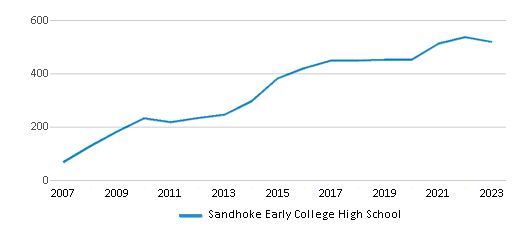
Gender %
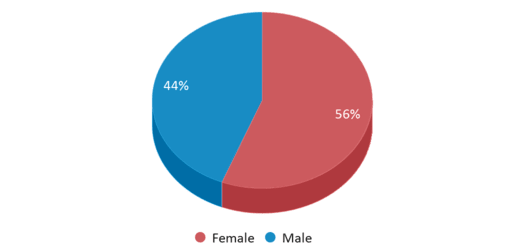
Total Classroom Teachers
20 teachers
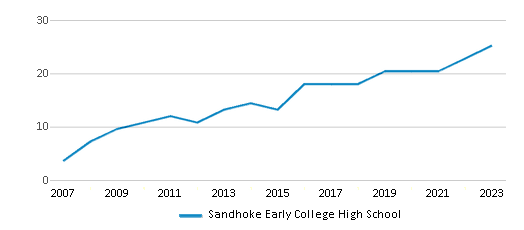
Students by Grade
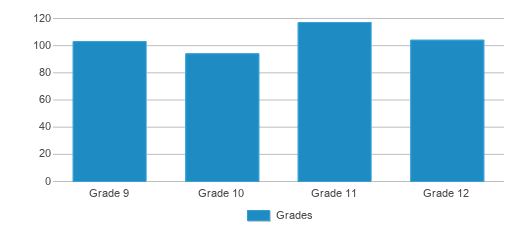
School Rankings
Sandhoke Early College High School ranks within the top 5% of all 2,617 schools in North Carolina (based off of combined math and reading proficiency testing data).
The diversity score of Sandhoke Early College High School is 0.76, which is more than the diversity score at state average of 0.71. The school's diversity has stayed relatively flat over five school years.
Overall Testing Rank
#38 out of 2617 schools
(Top 5%)
(Top 5%)
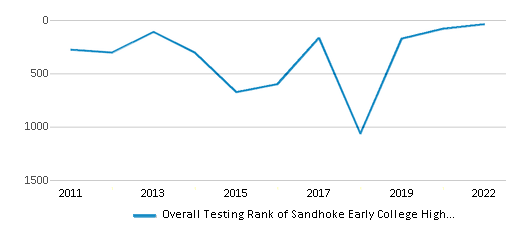
Math Test Scores (% Proficient)
85-89%
51%
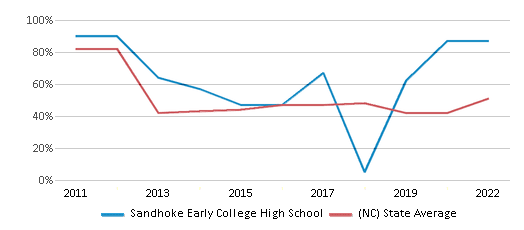
Reading/Language Arts Test Scores (% Proficient)
90-94%
50%
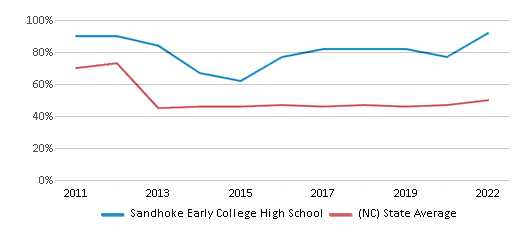
Science Test Scores (% Proficient)
85-89%
63%
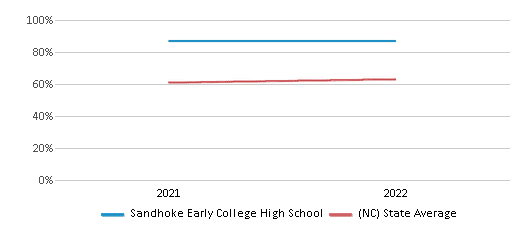
Student : Teacher Ratio
21:1
15:1

American Indian
4%
1%
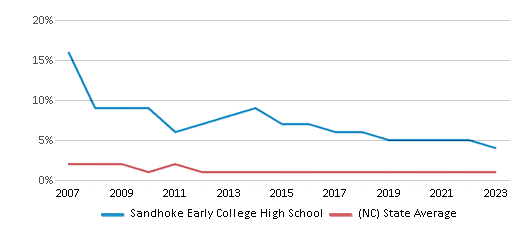
Asian
2%
4%
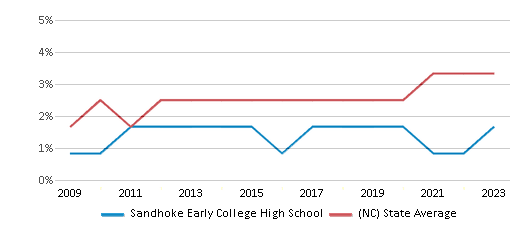
Hispanic
30%
21%
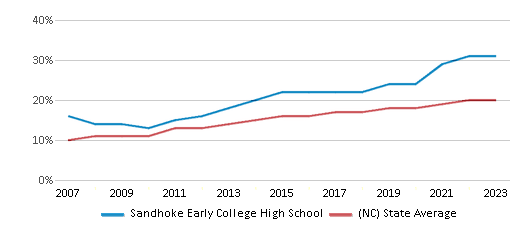
Black
29%
25%
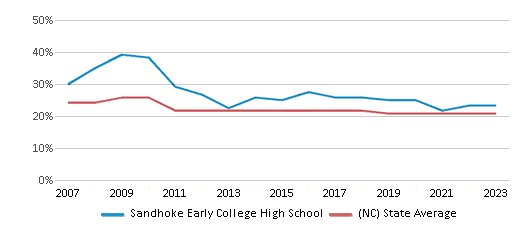
White
26%
43%

Hawaiian
n/a
n/a
Two or more races
9%
6%
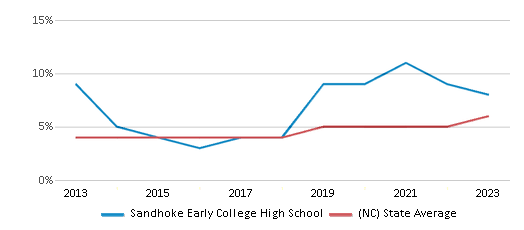
All Ethnic Groups
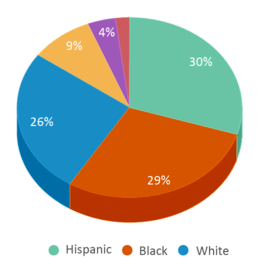
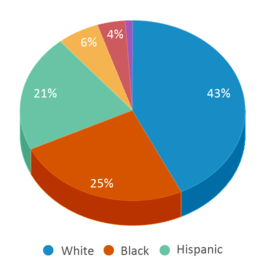
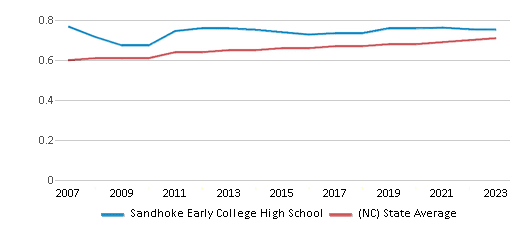
Graduation Rate
≥95%
86%
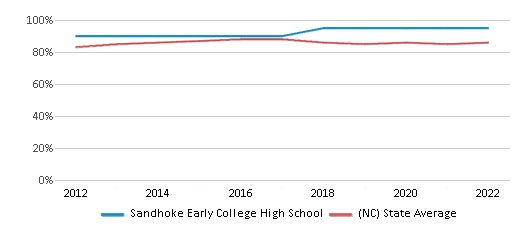
Participates in the National School Lunch Program (NSLP)
Yes
Eligible for Free Lunch
100%
68%
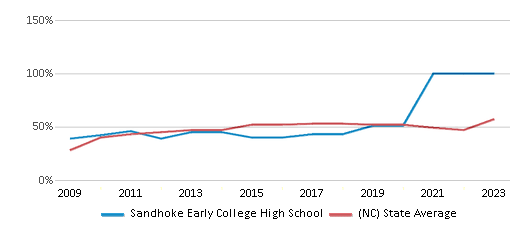
Eligible for Reduced Lunch (19-20)
4%
4%
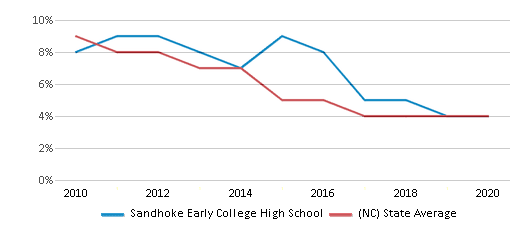
School Statewide Testing
School District Name
Source: National Center for Education Statistics (NCES), NC Dept. of Education
Profile last updated: 02/09/2025
Frequently Asked Questions
What is Sandhoke Early College High School's ranking?
Sandhoke Early College High School is ranked #38 out of 2,617 schools, which ranks it among the top 5% of public schools in North Carolina.
What schools are Sandhoke Early College High School often compared to?
Sandhoke Early College High Schoolis often viewed alongside schools like Hoke County High School by visitors of our site.
What percent of students have achieved state testing proficiency in math and reading?
85-89% of students have achieved math proficiency (compared to the 51% NC state average), while 90-94% of students have achieved reading proficiency (compared to the 50% NC state average).
What is the graduation rate of Sandhoke Early College High School?
The graduation rate of Sandhoke Early College High School is 95%, which is higher than the North Carolina state average of 86%.
How many students attend Sandhoke Early College High School?
418 students attend Sandhoke Early College High School.
What is the racial composition of the student body?
30% of Sandhoke Early College High School students are Hispanic, 29% of students are Black, 26% of students are White, 9% of students are Two or more races, 4% of students are American Indian, and 2% of students are Asian.
What is the student:teacher ratio of Sandhoke Early College High School?
Sandhoke Early College High School has a student ration of 21:1, which is higher than the North Carolina state average of 15:1.
What grades does Sandhoke Early College High School offer ?
Sandhoke Early College High School offers enrollment in grades 9-13 (offers virtual instruction).
What school district is Sandhoke Early College High School part of?
Sandhoke Early College High School is part of Hoke County Schools School District.
School Reviews
5 6/13/2022
I graduated last year and miss it! The teachers do make sure you understand the lesson and the school is small so it's really easy to make friends and know everybody. They do give lots of work though and the college classes can be a lot sometimes.
5 6/1/2020
Sandhoke is an amazing school that has helped me thrive and grow academically and mentally. The teachers really care about the students and get to know us individually. They also challenge us and force us to think in more innovative ways. There are a growing number of clubs, many of which are student led. Sports are accessible, but the school doesn't have any teams. To continue, there's recycling and the facilities are really nice, especially at the college campus. The school honestly feels like a really big family because we are smaller and even though Freshman year can be a kind of hard (due to higher expectations and changes), most students graduate with good memories and strong relationships. Also, most kids are very academic and plan on college after high school.
Review Sandhoke Early College High School. Reviews should be a few sentences in length. Please include any comments on:
- Quality of academic programs, teachers, and facilities
- Availability of music, art, sports and other extracurricular activities
Recent Articles

What Is A Charter School?
Explore the world of charter schools in this comprehensive guide. Learn about their history, how they operate, and the pros and cons of this educational innovation. Discover key facts about charter schools, including admission policies, demographics, and funding, as well as what to look for when considering a charter school for your child.

10 Reasons Why High School Sports Benefit Students
Discover the 10 compelling reasons why high school sports are beneficial for students. This comprehensive article explores how athletics enhance academic performance, foster personal growth, and develop crucial life skills. From improved fitness and time management to leadership development and community representation, learn why participating in high school sports can be a game-changer for students' overall success and well-being.

February 05, 2025
Understanding the U.S. Department of Education: Structure, Impact, and EvolutionWe explore how the Department of Education shapes American education, from its cabinet-level leadership to its impact on millions of students, written for general audiences seeking clarity on this vital institution.









